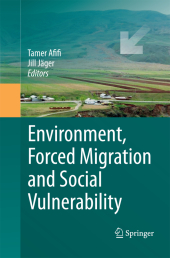 Neuerscheinungen 2014Stand: 2020-02-01 |
Schnellsuche
ISBN/Stichwort/Autor
|
Herderstraße 10
10625 Berlin
Tel.: 030 315 714 16
Fax 030 315 714 14
info@buchspektrum.de |

Tamer Afifi, Jill Jäger
(Beteiligte)
Environment, Forced Migration and Social Vulnerability
Herausgegeben von Afifi, Tamer; Jäger, Jill
2010. 2014. xv, 271 S. 5 Tabellen. 235 mm
Verlag/Jahr: SPRINGER, BERLIN; SPRINGER BERLIN HEIDELBERG 2014
ISBN: 3-642-43719-2 (3642437192)
Neue ISBN: 978-3-642-43719-9 (9783642437199)
Preis und Lieferzeit: Bitte klicken
This book examines linkages between environmental change and forced migration, presenting case studies of responses to climate and other environmental changes and examining the role of environmental change among the factors that lead to a decision to migrate.
This book is one of the outputs of the conference on ´Environmental Change, Forced Migration, and Social Vulnerability´ (EFMSV) held in Bonn in October 2008. Migration is one of the oldest adaptation measures of humanity. Indeed, without migration the multitude of civilizations and interactions between them - peaceful and otherwise - would be hard to imagine. The United Nations (UN)-led global dialogue on migration is a clear sign that governments and the specialized UN agencies and bodies have recognized the need to view, govern, manage, and facilitate migration; to mitigate its negative effects; and to capitalize on the positive ones. It is a common expectation among experts that environmentally induced migration will further increase in the decades to come. Hence, next to the political, economic, ethnic, social, financial, humanitarian, and security aspects of migration, the environmental component should urgently be considered in the ongoing international dialogue on migration. This need is also a challenge. Without appropriate scientific knowledge, assessment, definitions, and classifications, the intergovernmental frameworks would not be able to deal with these complex phenomena. The Five-Pronged-Approach as formulated by the United Nations University (UNU) may serve as a framework to identify the additional dimensions of this challenge next to - and actually simultaneously with - the scientific one.
Defining the Terms: Introduction.- Environmentally Induced Displacement and the 1951 Refugee Convention: Pathways to Recognition.- Institutional Barriers to the Recognition and Assistance of Environmentally Forced Migrants.- What´s in a Name: Social Vulnerabilities and the Refugee Controversy in the Wake of Hurricane Katrina.- Approaches for the Study of Forced Migration.- Forced Migration from Sub-Saharan Africa: The Conflict-Environment Link.- Solastalgia: Environmentally Induced Distress and Migration Among Africa´s Poor Due to Climate Change.- Climate Change and Migration.- Climate and Migration: A Synthesis.- Forced Migration of Alaskan Indigenous Communities Due to Climate Change.- ´Buscando la vida´ - How Do Perceptions of Increasingly Dry Weather Affect Migratory Behaviour in Zacatecas, Mexico?.- Migration and Other Forms of Environmental Degradation.- Environmental Migration from Rainfed Regions in India Forced by Poor Returns from Watershed Development Projects.- Migration to Contaminated Sites: Migrants´ Settlements in Central and Eastern Europe Built in Places with High Environmental and Social Vulnerability.- Migration and Natural Hazards: Is Relocation a Secondary Disaster or an Opportunity for Vulnerability Reduction?.- Guatemala: A Review of Historic and Recent Relocation Processes Provoked by Disasters of Natural Origin.- EACH FOR Case Studies and Scenarios.- Environmental Factors in Mexican Migration: The Cases of Chiapas and Tlaxcala.- Case Study Senegal: Environmental Degradation and Forced Migration.- The Environmental Root Causes Triggering Economic Migration: The Case of Egypt.- A Country Made for Disasters: Environmental Vulnerability and Forced Migration in Bangladesh.- In the Land of Ostriches: Developmentalism, Environmental Degradation, and Forced Migration in Turkey.- Environmental Migration: Case of Kyrgyzstan.- Linking the Earth´s Future to Migration: Scenarios of Environmental Change and Possible Impacts on Forced Migration.


